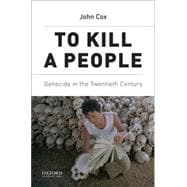There have been numerous books on genocide in the last twenty years, but To Kill a People offers a different approach. It is one of the few books on genocide expressly written for use in the college classroom. The book includes four case studies--the Armenian, Nazi, Cambodian, and Rwandan genocides--and substantive introductory and concluding chapters that contribute to two key debates within genocide studies: how to define "genocide" and place it in relation to other mass atrocities, and how to detect and analyze the social, historical, and cultural forces that produce genocidal violence.
To Kill a People examines a vast range of the latest research, offers original interpretations and arguments, and draws upon the author's own archival research on three continents. The case studies are supplemented by primary readings and thought-provoking questions, and the book concludes with a chapter that synthesizes the lessons and issues that arise from the study of genocide. A chapter-length bibliographic essay further distinguishes this book and will be useful to students and experts alike.








